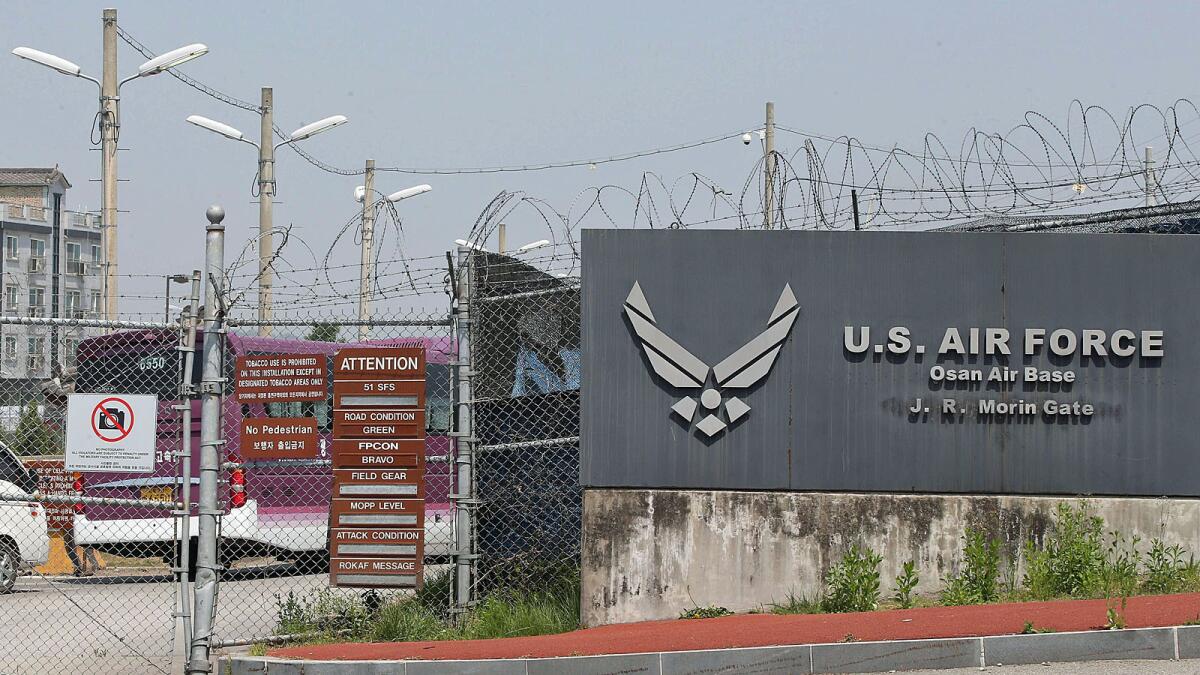26 people treated after Army’s accidental anthrax shipments

Of the 26 people affected by the Army’s accidental shipment of anthrax, 22 are being treated in South Korea.
- Share via
Reporting from Washington — At least 26 people are being treated for potential exposure to deadly anthrax after an Army biodefense facility in Utah mistakenly sent live samples to 18 private and military laboratories in as many as nine states and South Korea, officials said Thursday.
No confirmed infections were reported, and Pentagon officials insisted the accidental shipments of live Bacillus anthracis spores around the country, including to California, and halfway around the world posed no risk to the general public.
The Pentagon said four civilians at commercial labs in Delaware, Texas and Wisconsin were being given antibiotics as a safeguard.
The 22 others are being treated or vaccinated at a U.S. military laboratory at Osan Air Base in South Korea, where emergency response teams destroyed the anthrax sample. There were 5 active duty Air Force members, 10 active duty Army members, 2 Army Civilians, one Navy civilian and 4 contractors. A joint U.S.-Korean program at Osan aims to boost bio-surveillance capabilities on the Korean peninsula.
The U.S. Centers for Disease Control and Prevention said it was working with state and federal agencies to investigate how the anthrax samples were shipped from the Army’s Dugway Proving Ground, a vast facility in western Utah where researchers try to build and test defenses against chemical and biological agents, including lethal viruses and bacteria.
The anthrax samples were sent last month by commercial shipping companies to labs working to develop a new diagnostic test for anthrax, the CDC said.
The Army normally uses gamma radiation to render anthrax spores inactive before the material is sent to outside labs for research. But a private commercial lab in Maryland found that its sample contained live spores when it was cultured last Friday, and reported it to the CDC.
The CDC said it had sent investigators to all 18 labs and was trying to determine whether they all received live samples. Officials said the nine states also included New Jersey, New York, Tennessee and Virginia. None of the labs was publicly identified.
“At this time we do not suspect any risk to the general public,” the CDC said in a statement Thursday.
Officials are still trying to determine the source of the error, but infectious disease professionals expressed concern about a lack of oversight at Dugway.
“Clearly, this was a failure that never should have happened,” said Dr. Amesh Adalja, a member of the Infectious Diseases Society of America, a medical association based in Arlington, Va. “Biomedical safety is essential when handling these sorts of agents. We need to get to the bottom of this and find out how it occurred, so it doesn’t happen again.”
Anthrax is an acute bacterial disease that can be fatal if not treated. It is not contagious but can be inhaled, ingested or transmitted through direct contact on the skin. Someone who is infected may not show symptoms for weeks.
The case is the latest in which U.S. military mishandling of anthrax has set off a scare.
Last June, Michael Farrell, the head of the CDC’s Bioterror Rapid Response and Advanced Technology Laboratory, resigned after the lab failed to properly kill live anthrax samples and moved the material to an area where workers were not required to wear protective gear. Dozens of people were exposed but no one was infected.
The nation’s worst biological attack also involved anthrax created in an Army facility.
Less than a month after the Al Qaeda attacks on Sept. 11, 2001, five envelopes containing dried anthrax spores were sent to several members of Congress and the media, sparking widespread fear of a debilitating terrorist attack.
At least 22 people contracted anthrax, and five died from the infection. The attack disrupted mail and other government services, as experts struggled to decontaminate 35 post offices and mail rooms, as well as several buildings on Capitol Hill.
After years of false starts, the FBI concluded in 2008 that Dr. Bruce E. Ivins, a researcher at the U.S. Army Medical Research Institute of Infectious Diseases at Ft. Detrick, Md., was responsible. He committed suicide before he was charged.
------------
For the record:
1:11 p.m., May 28: An earlier version of this post misspelled the last name of Dr. Bruce Ivins as Ivans. Also, an earlier headline on this post incorrectly said anthrax shipments ended up in nine states. Anthrax was shipped to as many as nine states but only live Anthrax was discovered in Maryland so far.
------------
More to Read
Sign up for Essential California
The most important California stories and recommendations in your inbox every morning.
You may occasionally receive promotional content from the Los Angeles Times.














